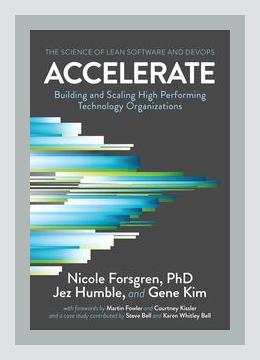Technology and Digital TransformationIT Management
Summary of “Accelerate: The Science of Lean Software and DevOps: Building and Scaling High Performing Technology Organizations”
Authors: Nicole Forsgren, Jez Humble, Gene Kim
Category: IT Management
Published: 2018
Introduction
“Accelerate” by Nicole Forsgren, Jez Humble, and Gene Kim is an influential book that delves into the metrics, practices, and cultural factors that make high-performing technology organizations successful. Based on rigorous research and analytics, the book outlines actionable strategies to enhance software delivery performance and describes the impact of adopting lean and DevOps principles.
Main Points and Examples
1. Key Metrics for Performance
-
Lead Time for Changes: The time it takes to go from code committed to code successfully running in production.
- Action: Implement continuous integration and deployment practices to reduce lead time.
- Example: High-performing organizations achieve lead times for changes measured in hours, compared to low performers who take weeks or months.
-
Deployment Frequency: How often an organization successfully deploys to production.
- Action: Automate deployment processes to increase deployment frequency.
- Example: Elite performers deploy multiple times per day, whereas low performers deploy between once per month and once every six months.
-
Mean Time to Restore (MTTR): The average time it takes to recover from a failure.
- Action: Implement robust monitoring and incident response plans.
- Example: High performers recover from incidents in less than an hour, compared to low performers who take between one week and one month.
-
Change Failure Rate: The percentage of changes that fail in production.
- Action: Conduct regular, automated testing and integrate continuous feedback loops.
- Example: Elite performers have change failure rates ranging from 0-15%, whereas low performers experience failure rates from 46-60%.
2. Technical Practices for Accelerating Delivery
-
Continuous Delivery: Utilizing practices like version control, automated testing, and trunk-based development to enable frequent, reliable software releases.
- Action: Adopt trunk-based development to reduce integration errors and simplify merging.
- Example: Teams employing continuous delivery practices report a higher percentage of successful deployments.
-
Lean Management Practices: Limiting work in progress, engaging in small batch work, and ensuring teams work in close communication to optimize flow.
- Action: Visualize flow with Kanban boards and limit work-in-progress to streamline processes.
- Example: Organizations using lean management practices achieve faster and more predictable lead times.
-
DevOps Techniques: Implementing automations, reducing manual tasks, fostering cross-functional collaboration, and encouraging ownership among developers.
- Action: Invest in infrastructure as code, continuous delivery pipeline, and security automation.
- Example: Companies adopting DevOps see significant improvements in both software delivery performance and team morale.
3. Importance of Culture
-
Generative Culture (High Cooperation and Trust): High-performing organizations exhibit a culture of high trust, collaboration, and a focus on shared goals.
- Action: Foster a culture of blameless post-mortems and encourage psychological safety to discuss failures openly.
- Example: Teams with a generative culture are better at problem-solving and innovation.
-
Leadership Techniques: Transformational leadership, where leaders inspire and motivate their teams by creating a vision and leading by example.
- Action: Leaders should empower teams, delegate decision-making, and provide the resources necessary for success.
- Example: Leaders who practice transformational leadership see increased engagement and productivity in their teams.
4. Learning and Experimentation
-
Shift Left on Security: Integrating security practices into the software delivery process early to identify and mitigate risks sooner.
- Action: Integrate security tests into the continuous integration pipeline.
- Example: Early integration of security practices can significantly reduce the number of vulnerabilities discovered later in the development process.
-
Feedback Loops: Incorporating fast feedback loops to quickly learn from experiments and make necessary adjustments.
- Action: Use automated testing and monitoring tools to get immediate feedback on code changes.
- Example: High-performing teams implement quick feedback mechanisms to continuously improve their code and processes.
5. Management and Monitoring
-
Effective Use of Metrics: Utilizing data and metrics to drive decision-making and continuous improvement.
- Action: Regularly review and analyze key performance indicators (KPIs) to identify areas of improvement.
- Example: Teams that effectively use data-driven insights see consistent improvements in their performance metrics.
-
Empowering Teams: Providing teams with the autonomy and tools they need to take ownership of their work.
- Action: Implement self-service capabilities for development and operation tasks.
- Example: Empowered teams tend to be more innovative and reactive to changes, leading to better performance outcomes.
Conclusion
“Accelerate” provides a comprehensive blueprint backed by scientific research that guides organizations in transforming their software delivery practices and achieving high performance. The key to success lies in understanding the right metrics, fostering a generative culture, adopting lean and DevOps practices, encouraging continuous learning, and using data-driven decision-making.
By implementing the specific actions outlined in response to each major point, organizations can begin to see improvements in their processes, team morale, and overall performance, ultimately leading to more frequent, reliable, and secure software releases.
